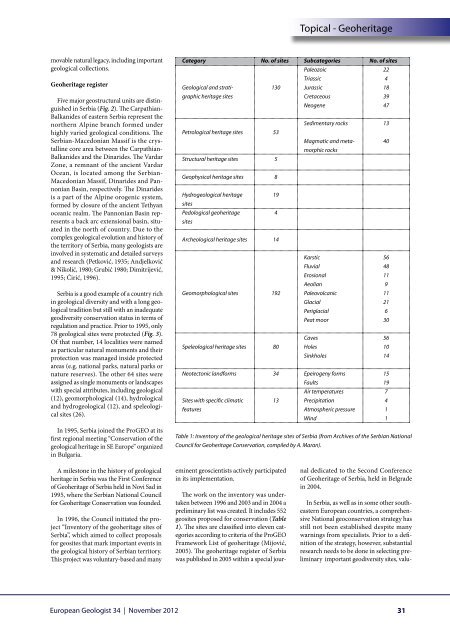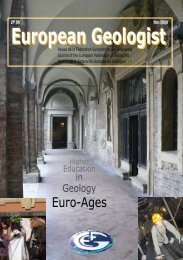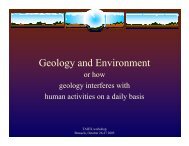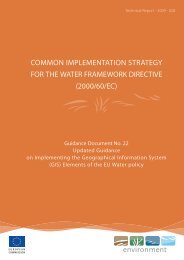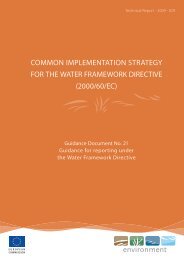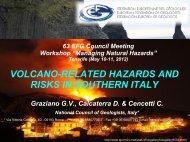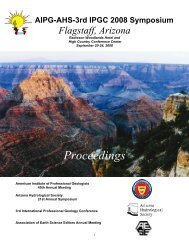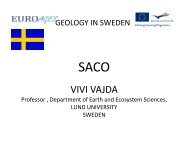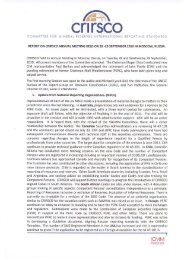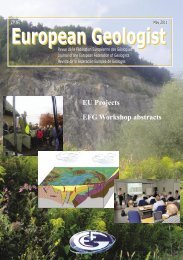European Geologist European Geologist Geoheritage - learning ...
European Geologist European Geologist Geoheritage - learning ...
European Geologist European Geologist Geoheritage - learning ...
You also want an ePaper? Increase the reach of your titles
YUMPU automatically turns print PDFs into web optimized ePapers that Google loves.
Topical - <strong>Geoheritage</strong><br />
movable natural legacy, including important<br />
geological collections.<br />
<strong>Geoheritage</strong> register<br />
Five major geostructural units are distinguished<br />
in Serbia (Fig. 2). The Carpathian-<br />
Balkanides of eastern Serbia represent the<br />
northern Alpine branch formed under<br />
highly varied geological conditions. The<br />
Serbian-Macedonian Massif is the crystalline<br />
core area between the Carpathian-<br />
Balkanides and the Dinarides. The Vardar<br />
Zone, a remnant of the ancient Vardar<br />
Ocean, is located among the Serbian-<br />
Macedonian Massif, Dinarides and Pannonian<br />
Basin, respectively. The Dinarides<br />
is a part of the Alpine orogenic system,<br />
formed by closure of the ancient Tethyan<br />
oceanic realm. The Pannonian Basin represents<br />
a back arc extensional basin, situated<br />
in the north of country. Due to the<br />
complex geological evolution and history of<br />
the territory of Serbia, many geologists are<br />
involved in systematic and detailed surveys<br />
and research (Petković, 1935; Andjelković<br />
& Nikolić, 1980; Grubić 1980; Dimitrijević,<br />
1995; Ćirić, 1996).<br />
Serbia is a good example of a country rich<br />
in geological diversity and with a long geological<br />
tradition but still with an inadequate<br />
geodiversity conservation status in terms of<br />
regulation and practice. Prior to 1995, only<br />
78 geological sites were protected (Fig. 3).<br />
Of that number, 14 localities were named<br />
as particular natural monuments and their<br />
protection was managed inside protected<br />
areas (e.g. national parks, natural parks or<br />
nature reserves). The other 64 sites were<br />
assigned as single monuments or landscapes<br />
with special attributes, including geological<br />
(12), geomorphological (14), hydrological<br />
and hydrogeological (12), and speleological<br />
sites (26).<br />
In 1995, Serbia joined the ProGEO at its<br />
first regional meeting “Conservation of the<br />
geological heritage in SE Europe” organized<br />
in Bulgaria.<br />
Category No. of sites Subcategories No. of sites<br />
Geological and stratigraphic<br />
heritage sites<br />
130<br />
Paleozoic<br />
Triassic<br />
Jurassic<br />
Cretaceous<br />
Neogene<br />
22<br />
4<br />
18<br />
39<br />
47<br />
Petrological heritage sites 53<br />
Sedimentary rocks<br />
13<br />
Magmatic and metamorphic<br />
40<br />
rocks<br />
Structural heritage sites 5<br />
Geophysical heritage sites 8<br />
Hydrogeological heritage<br />
19<br />
sites<br />
Pedological geoheritage<br />
4<br />
sites<br />
Archeological heritage sites 14<br />
Geomorphological sites 192<br />
Karstic<br />
Fluvial<br />
Erosional<br />
Aeolian<br />
Paleovolcanic<br />
Glacial<br />
Periglacial<br />
Peat moor<br />
56<br />
48<br />
11<br />
9<br />
11<br />
21<br />
6<br />
30<br />
Speleological heritage sites 80<br />
Caves<br />
Holes<br />
Sinkholes<br />
56<br />
10<br />
14<br />
Neotectonic landforms 34 Epeirogeny forms<br />
Faults<br />
15<br />
19<br />
Sites with specific climatic<br />
features<br />
13<br />
Air temperatures<br />
Precipitation<br />
Atmospheric pressure<br />
Wind<br />
7<br />
4<br />
1<br />
1<br />
Table 1: Inventory of the geological heritage sites of Serbia (from Archives of the Serbian National<br />
Council for <strong>Geoheritage</strong> Conservation, compiled by A. Maran).<br />
A milestone in the history of geological<br />
heritage in Serbia was the First Conference<br />
of <strong>Geoheritage</strong> of Serbia held in Novi Sad in<br />
1995, where the Serbian National Council<br />
for <strong>Geoheritage</strong> Conservation was founded.<br />
In 1996, the Council initiated the project<br />
“Inventory of the geoheritage sites of<br />
Serbia”, which aimed to collect proposals<br />
for geosites that mark important events in<br />
the geological history of Serbian territory.<br />
This project was voluntary-based and many<br />
eminent geoscientists actively participated<br />
in its implementation.<br />
The work on the inventory was undertaken<br />
between 1996 and 2003 and in 2004 a<br />
preliminary list was created. It includes 552<br />
geosites proposed for conservation (Table<br />
1). The sites are classified into eleven categories<br />
according to criteria of the ProGEO<br />
Framework List of geoheritage (Mijović,<br />
2005). The geoheritage register of Serbia<br />
was published in 2005 within a special journal<br />
dedicated to the Second Conference<br />
of <strong>Geoheritage</strong> of Serbia, held in Belgrade<br />
in 2004.<br />
In Serbia, as well as in some other southeastern<br />
<strong>European</strong> countries, a comprehensive<br />
National geoconservation strategy has<br />
still not been established despite many<br />
warnings from specialists. Prior to a definition<br />
of the strategy, however, substantial<br />
research needs to be done in selecting preliminary<br />
important geodiversity sites, valu-<br />
<strong>European</strong> <strong>Geologist</strong> 34 | November 2012<br />
31


